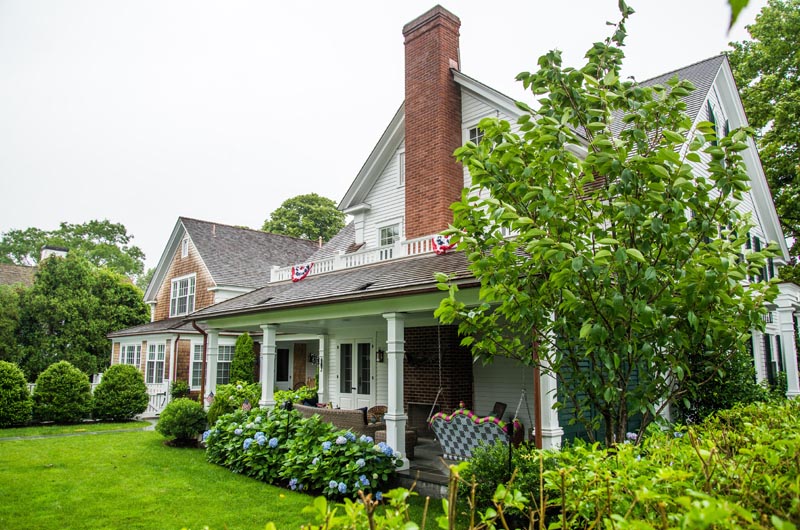A quick drive around Martha’s Vineyard reveals a tapestry of architectural styles, from the stately homes of former whaling captains in Edgartown to the colorful Victorian gingerbread houses in Oak Bluffs to the many newer homes up-Island.
Within the Island’s several historic districts formed since the 1970s, houses and styles often span centuries, telling a story of both past and present.
Residential construction on the Island, including historic renovation, has picked up in recent years as the economy rebounds and more people visit or move to the Island. Much of the construction is centered in Edgartown, the Island’s oldest town, and the first, in 1987, to adopt a historic district.
Patrick Ahearn, a leading Island architect who has worked on more than 120 buildings in Edgartown over the past few decades, said this year has been among his busiest yet. Maggie White, owner of Hob Knob Construction in downtown Edgartown, said there are probably four projects underway on each block.
Construction is occurring within and around the historic district, which spans North and South Water streets along Edgartown harbor and several blocks west along Main street.
Mr. Ahearn strives to design houses that honor the town’s past while also meeting the demands of modern clients, he said. He leans to airy, open interiors and trying to create a harmony between indoor and outdoor spaces typical of New England architecture. He knows he is successful when people are unable to identify the new homes in a historic area.
“I’m more like a ghost in the night,” he said. “At the end of the day you never really knew I was there.”
Sometimes historic renovations themselves contribute to Island history. For example, a group of local firms including Hob Knob and Hutker Architects recently renovated the Capt. Ellsworth West house at 52 South Summer street, which was built in 1860. The project was done in partnership with local philanthropists Christopher Celeste and Nancy Kramer, and some of the profits will go toward the construction of schools and community centers in developing countries.
The Edgartown Historic District Commission, which oversees all development in the village, required that the project remain faithful to the house’s 1860 design, right down to the original trim profile.
“[The commission] mandates the look and the feel,” said Ms. White, adding that in some cases a house “may be brand new, but it looks like it’s 200 years old.”
Phil Regan, principal of Hutker Architects, has served on the Cottage City Historic District Commission in Oak Bluffs since its founding in the 1990s. Edgartown and Oak Bluffs are worlds apart, he said. Each developed at a different time and for different reasons — Edgartown as a wealthy whaling port and Oak Bluffs as a seasonal community for people of more modest means. Many of the historic homes in Oak Bluffs are family heirlooms, he said, and renovations are less frequent.
Oak Bluffs has the largest historic district on the Island, although it does not include the original Camp Ground and other historic areas. Like Edgartown, it has a style all its own. But preserving that style requires a different approach than in Edgartown. Mr. Regan said that Oak Bluffs’ aging Victorian houses, with their lightweight frames and elaborate woodwork and designs, “would by no means meet the building code today,” which makes restoration more of a challenge.
Many of the original porch railings, for example, were designed to be shorter than what the current building code allows. The building code also requires larger windows and doors than one would find in many of the original houses.
“The building code is so stringent now that we just can’t do a lot of what makes that historic architecture special,” Mr. Regan said. But in some cases, when a house is renovated, architectural features can be repurposed elsewhere in the house.
Oak Bluffs was one of the first communities in the United States to be designed according to a master plan. Its parks, intimate neighborhoods, small house lots and walkability were designed to encourage a sense of community. Mr. Regan, who grew up in Oak Bluffs, remembers that sense very clearly. “Everybody was always out on the porches. You could smell what was cooking in the kitchens in every house on every street, and everybody knew everybody.”
Town planners in Oak Bluffs are hoping to restore the neighborhood’s pedestrian focus as more and more cars fill the streets. They are also tackling the issue of how to preserve the historic buildings in the downtown business district, which is not part of the historic district.
Mr. Regan pointed out that while towns rely in large part on their historic districts, the Martha’s Vineyard Preservation Trust has been active in purchasing and restoring properties throughout the Island, including Union Chapel and the Flying Horses Carousel in Oak Bluffs, and the Old Whaling Church in Edgartown. Towns also have access to Community Preservation Act funds, which can be used for historic preservation.
Mr. Ahearn said that in Edgartown, residential development in the village has benefitted local business and helped foster a sense of community. He pointed to the village as an example of New Urbanism, a design movement that encourages walkability and historic preservation.
“Edgartown is a living and breathing original town that has all of the attributes that people are trying to create in new construction,” he said.
Craig Whitaker, a New York city architect and member of the Vineyard Haven Historic District Commission, pointed out that change is inevitable, even in historic districts. “Unless you are going to preserve the place in amber, you really have to allow for changes,” he said.
For Mr. Whitaker, the goal for each historic building is to “try to make it fit, with a full knowledge that there is no such thing as something that is completely historic.”








Comments (1)
Comments
Comment policy »